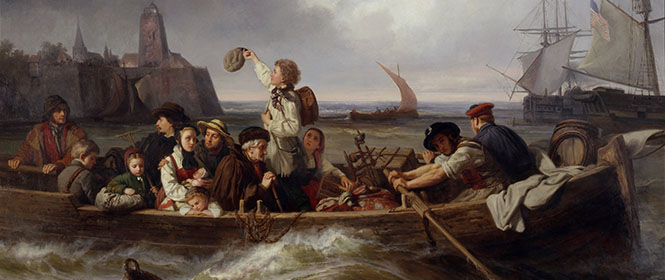
GERMANY AS A LAND OF EMIGRATION
WHY MILLIONS OF PEOPLE LEFT THE COUNTRY
Germany is a country of immigration. An exhibition entitled ‘Multicultural’, which is showing at the Deutsches Historisches Museum (German Historical Museum), illustrates why this statement sounds so self-evident in 2016.
Germany, however, was not always a destination for emigrants in search of a better life, but for many years the starting point of their journey. In the 19th century, millions of people left Germany to start an uncertain new life in foreign climes.
‘There is no longer any way to hold back the tide of emigration and migration,’ reported the Allgemeine Auswanderungs-Zeitung in its first issue, which was published on 20 September 1846. Between 1850 and 1870 alone, some two million people left German federal territory – with most of them crossing the Atlantic by ship. This figure was equivalent to four times the population of contemporary Berlin.
THE AMERICAN DREAM
The destination of choice for the majority of emigrants was a legendary nation in the West: the United States of America. Travel writing helped to sell the notion that emigrants would find a better life in the New World. In 1829, for instance, Gottfried Duden extolled the virtues of ‘immensely fertile land that stretches for mile after mile, a mild climate, complete safety for people and property, all with very low taxation.’ During his time in the US, Duden worked as a doctor, writer, farmer and justice of the peace.
To borrow from the terminology of modern-day migration theory, pull factor after pull factor came together to make the US attractive, especially for so-called economic migrants. ‘The poorest man here has a better life than one who is two rungs higher in Europe,’ confirmed traveller H.W.E. Eggerling. He wrote a Kurze Beschreibung der Vereinigten Staaten von Nord-Amerika (Short Description of the United States of North America), which was published in 1832.
This glorified account of living conditions on the other side of the Atlantic did not go unnoticed in Germany. Whilst the political and social conditions in the New World seemed idyllic, they were very often uncertain in the Old World.
The failed popular, pro-democracy March Revolution of 1848 and 1849 and the ensuing reactionary clampdown encouraged many liberally minded citizens to emigrate. Furthermore, abject poverty was rife in many regions of Germany, with the years 1846 and 1847 dominated by the last major famine of the pre-industrial age. Failed harvests and the potato blight that had been rampant ever since 1844 served to ravage supplies.
Agriculture and the emerging industrial sector were simply unable to feed the growing population. In particular, it was just not possible for unskilled manual workers and labourers to provide for their families. It seemed to these people that the only chance of a better life lay far from home.
TRADING WITH HOPE
The yearned-for fresh start was preceded by an arduous journey. If the weather was favourable, emigrants crossed the Atlantic in six weeks, but the journey could sometimes last up to twelve. On the steamers of the day, which would embark from Bremen, Bremerhaven and Hamburg, the destitute migrants would travel ‘in steerage’ – the cramped quarters between decks. The regulations stipulated a minimum height of just 1.72 metres.
The travellers had little in the way of comfort. Their sleeping, dining and living quarters were packed into a space that barely exceeded one square metre, with the problems compounded by deplorable hygiene and a lack of medical care.
For some people, however, emigration was big business. HAPAG boss Albert Ballin is alleged to have said that ‘without steerage passengers, I’d go bankrupt in just a few weeks.’ when talking about his company, which went on to become the world’s largest shipping firm.
PROSPECTS GIVE WAY TO POVERTY
Although the emigrants set sail with high hopes, they faced an uncertain future. The journey was not an adventure, but the next chapter in their fight for survival. With her 1860 painting Farewell of the emigrants, which can be admired in the permanent exhibition of the Deutsches Historisches Museum, Antonie Volkmar magnificently captures the contrasting emotions of hope and fear. The emigrants had good reason to be fearful. Even though some of them managed to advance in American society, many Germans found themselves living in abject poverty or toiling away as cheap labour in their new home.
Overall, Germans represented the largest group of migrants to the US. They were not universally welcomed. ‘The long-held fear has finally become reality; in order to save its own skin when faced with a tide of dependent and completely helpless people, the United States of America has enacted very harsh immigration laws,’ wrote the Allgemeine Auswanderungs-Zeitung in 1847. Nevertheless, the waves of emigration only began to subside in the late 19th century, when Germany’s economy entered a period of boom, enabling large parts of the population to climb out of poverty for the first time.